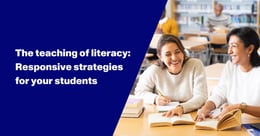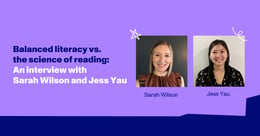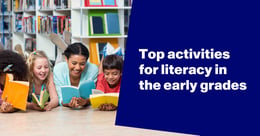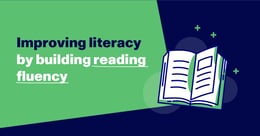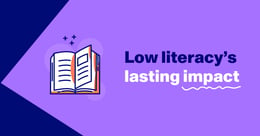
How does reading aloud help students to develop literacy skills?
If you happen to find yourself in a family home or an elementary school class, the room will often fill with a sweet, nostalgic sound: An adult reciting the words of a story to a child, or a child reciting the story themselves.
Maybe it’s a classic picture book like “The Very Hungry Caterpillar” or “Goodnight Moon.” Perhaps it’s a passage from “Diary of a Wimpy Kid” or an interesting piece of nonfiction covering a topic a learner has been interested in recently. No matter the text, though, reading aloud to kids helps adults model confident and fluent reading. It’s no wonder why children request these activities again and again—sitting transfixed throughout them—and why they’re such a common instructional practice.
At the same time, children who regularly practice their reading skills out loud can also boost their own reading achievement. In this piece, we’ll explore the many benefits of reading out loud for learners. Then, we’ll share some tried and true ways to incorporate this practice into your literacy teaching strategy.
The comprehensive benefits of reading aloud to children
What are the proven benefits of reading out loud to children?
Adult-led oral reading is key to a well-rounded literacy development strategy for young ones. According to an article on reading aloud from Reading Rockets, an educational resource affiliated with public broadcasting station WETA, reading out loud to children is foundational to literacy development: Research demonstrates that it’s one of the most powerful activities when it comes to ensuring success in literacy, helping children see what “phrased, fluent reading” looks like. Likewise, experts note that reading to learners makes clear the rich benefits of reading itself by developing young ones’ love of books and desire to consume written material on their own.
And though it’s proven that parents, caregivers, and educators who read stories out loud will impart many benefits onto children, it’s worth repeating that these effects can be complemented by having children practice their own oral reading skills, whether they’re alone, with trusted adults, or in a group setting.
How children benefit from self-led oral reading practice
Having children read out loud is beneficial—just like adult-led reading.
How exactly does reading aloud help students to develop literacy skills? In particular, it has a positive impact on reading fluency and achievement, notes a Reading Rockets primer on fluency. “Students who read and reread passages orally as they receive guidance and/or feedback become better readers,” the article notes. Likewise, “repeated oral reading substantially improves word recognition, speed, and accuracy as well as fluency.” At the same time, oral reading practice also has the potential to boost learners’ reading comprehension.
The National Reading Panel conducted a meta-analysis of existing authoritative research on instructional practices involving guided oral reading. The panel found that these guided and repeated oral reading exercises—specifically ones that incorporated guidance from educators, peers, and parents or caregivers—had an appreciable positive effect on metrics such as:
- Word recognition
- Comprehension
- Fluency
Notably, the positive impact was also widespread: It was seen across grade levels and reading levels as well as in special education classrooms and general learning environments. Similarly, a study on reading comprehension among children with reading-related disabilities found that participants understood more through the process of oral rather than silent reading.
Older learners may also see benefits
Although oral reading exercises often end when students graduate from elementary school, older learners may benefit as well. A study covering oral reading fluency activities in a high-intervention setting found that high schoolers who took part in an oral reading activity saw demonstrable increases in both fluency and reading comprehension.
Oral reading activities to improve reading skills in students
With all of the benefits of oral reading, which activities will improve reading skills in students? A few oral reading tactics have become well loved among educators who want to craft a solid approach to teaching literacy.
[READ: “How to teach reading: The K-12 guide”]
1. Choral reading
This practice involves having your class read a text out loud in unison, and proponents assert that choral reading is a particularly powerful way to boost learners’ fluency while preserving their confidence.
That’s because traditional classroom reading activities—think “round robin” or popcorn-style reading—may inadvertently single out students who are having a tough time with reading. On the other hand, the team-based nature of choral reading means educators and agile readers can actually guide students who are diligently shoring up their literacy skills.
[READ: “In-class activities for building literacy in the early grades”]
Perhaps the stress-free nature of choral reading activities is why they not only improve readers’ fluency and vocabulary chops, but also encourage a love of literature. And these benefits may be even more pronounced for students with disabilities and English learners: In a paper on choral reading for students with exceptionalities published in the Georgia Journal of Literacy, Dr. Harriet J. Bessette writes that “for students with exceptionalities who are striving readers, the benefits of choral reading may be even greater than for their typically developing peers.” Bessette also references research suggesting that choral reading practices can enhance fluency among “culturally and linguistically diverse learners.”
So, what does this look like in the classroom? An Edutopia article on the benefits of reading aloud as a group draws focus to New York’s Concourse Village Elementary School, where learners take part in choral reading by reciting a chosen text each day throughout a week as a whole class. Students also practice reading out loud in pairs and by themselves, and each reading day focuses on a new literacy skill: Think uncovering a main idea, making annotations, or coming up with conclusions.
“Because the reading of a single, challenging text is scaffolded over five days, with plenty of teacher modeling and support, students learn a valuable and portable method for decoding difficult texts,” writes author Sarah Gonser.
2. Paired reading buddies
After completing choral reading—or perhaps similar exercises—breaking students up into smaller groups to practice reading could provide additional benefits.
One especially supportive way to take advantage of the benefits of reading out loud for students is to assign cross-grade “reading buddies.” In an article on elementary reading strategies, Edutopia’s Emelina Minero writes that matching up students in pairs—one from a younger grade and another from an older grade—can provide academic, social, and emotional benefits for both parties. “The little kids see greater reading fluency modeled and profit from the one-to-one attention of a mentoring relationship,” Minero notes. “The upper elementary kids learn by answering questions and develop crucial skills like empathy and patience.”
Overall, reading buddy exercises offer plenty of benefits for everyone involved, from boosting learners’ confidence to providing positive role models, demonstrating literary fluency, and creating leadership opportunities.
Overall, reading buddy exercises offer plenty of benefits for everyone involved, from boosting learners’ confidence to providing positive role models, demonstrating literary fluency, and creating leadership opportunities.
But this kind of exercise may also be particularly helpful for striving readers in older grades who have fallen behind their peers. As they hone leadership skills by guiding their younger buddies through a text, they’re also able to gain valuable practice in foundational skills by spending more time with books written at a lower reading level—without the self-consciousness they might feel if they did so around their peers.
[READ: “More than just reading: Why low literacy has a lasting impact”]
Minero suggests having student pairs meet at least once monthly for a half-hour. Younger children should be able to choose the first text to make sure they’re excited and engaged for the project, but older kids can choose their favorite texts later too. As time goes on, younger kids who have improved their reading levels may also choose to take on the reading rather than the listening role every once in a while.
3. Ongoing independent oral reading
In making these exercises more independent, we arrive at another activity that may prove helpful for educators teaching literacy: ongoing opportunities to practice independent reading. In short, this involves having students practice oral reading on their own time.
Here, the old cliche of “practice makes perfect” rings true: An article published in the International Electronic Journal of Elementary Education on how reading volume impacts both fluency and achievement says that although reading volume is often overlooked, it’s critical in the development of reading achievement and oral reading fluency.
Likewise, independent reading practice is a fruitful activity many educators may not think to take advantage of. Author Dr. Richard L. Allington notes that schools don’t often monitor the amount of reading children do, and common reading programs employed in schools only spur roughly 15 minutes of daily reading for learners.
Although reading volume is often overlooked, it’s critical in the development of reading achievement and oral reading fluency. Likewise, independent reading practice is a fruitful activity many educators may not think to take advantage of.
Educators can certainly assign students a task to read a text of their choice or selected material out loud at home, but in-depth reading platforms may provide a more engaging and data-driven way to complete independent oral reading practice.
Paper Reading, for instance, is a literacy tool that works to drive independent reading habits among learners. The tool records students as they read out loud, provides a transcript, and includes statistics students can refer back to—minutes read, unique words, and pace among them. Teachers also benefit from avoiding manual calculations surrounding reading proficiency and can see how students improve over time.
Paper Reading measures learners’ progress in a data-driven way, but the platform itself is low-pressure. The interface encourages leisurely reading and promotes the practice of voluntary reading among learners.
Wondering how an all-in-one reading tool can help your learners develop literacy? Learn how Paper Reading can strengthen these skills.

